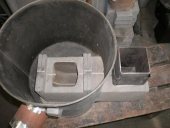Howdy!
My first post to Permies after lurking from the interwebs for quite awhile now. I was inspired by this site and the posts by Ernie & Erica Wisner and Gary Park pertaining to rocket stoves and rocket mass heaters. I'm on my way to learning as much about them as I can, as a hobby. I'm also currently a student of Instrumentation and Control technology; a subject that merges my love for tackling interesting problems with the art need to tinker and turn wrenches.
Enough intro for now. The real reason I'm here. Today at school my lab group completed the assembly of an automated educting system for control of fire temperatures in a rocket heater. We've decided to use a metal 5 gallon pail as a model for a larger stove. The inlet and exhaust are 4" diameter steel pipes. The pail is lined with firebrick and perlite. In the exhaust we've installed a steel pipe tube which introduces an airflow that pulls air through the stove via a force air blower. Video of our first burn is available here:
https://www.youtube.com/watch?v=V1DZHMEIphw&featur...l&context=G221293aFAAAAAAAAAAA
I'm writing because I would like to know if anyone has measured the temperatures across the primary flame in a rocket stove before. Using cedar shake as our fuel, today we achieved temps ranging from 1200F to 1450F with fairly easy control using variable blower speeds.
When working on my own model of this stove, I will pursue the installation of the mass portion by capping the exhaust (sans blower) with a 30-gallon steel drum and assembling the exhaust for the cobb surround. And tips I should follow as to appropriate inlet and exhaust tubing sizes for a stove/heater of that size?
Thanks very much for your awesome sight, and positive forum contributions. Cheers, Travis










